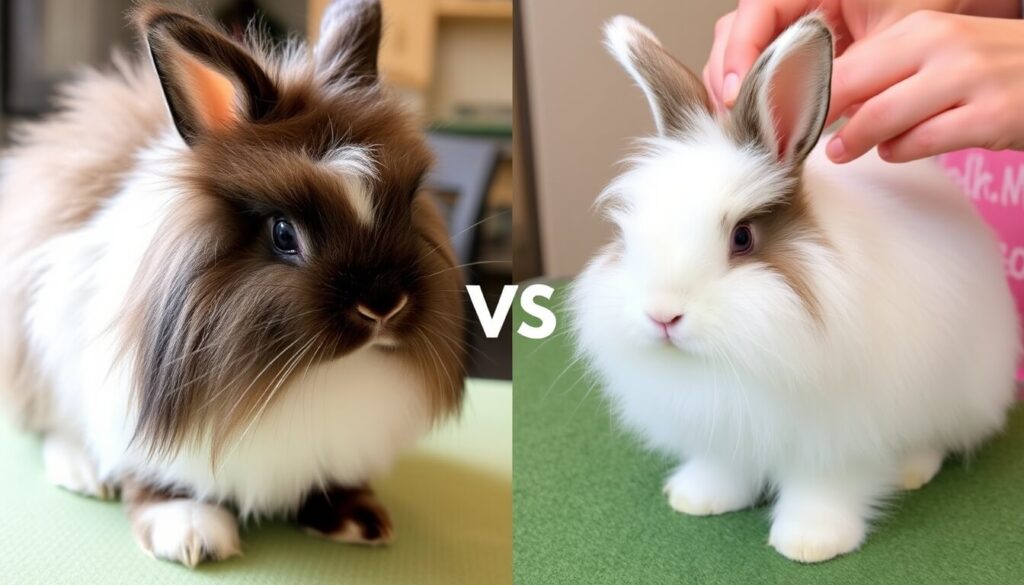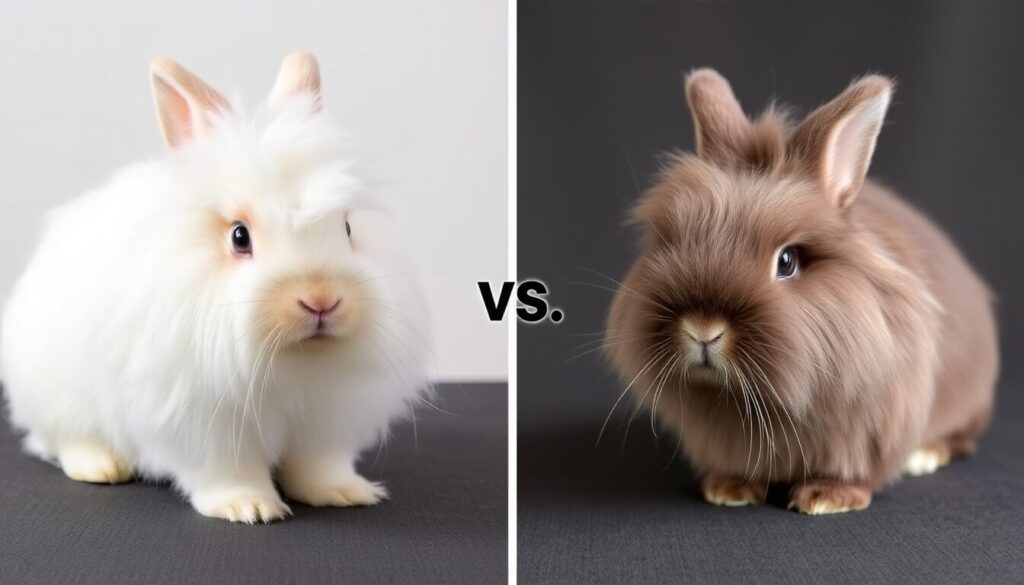Physical Differences
There are noticeable differences between the English Angora Rabbit and the French Angora Rabbit when it comes to their physical appearance. Let’s break it down:
| Category | English Angora Rabbit | French Angora Rabbit |
|---|---|---|
| Origin | England | France |
| Coat Appearance | Dense wool, including on the face and feet | No wool on the face or front feet |
| Wool Type | Fine, soft, luxurious wool | Coarser wool is easier to maintain |
| Size and Weight | Smaller, around 5-7 pounds | Larger, around 7-10 pounds |
| Body Shape | Compact, round, puffball-like appearance | Streamlined body, traditional rabbit look |
| Face Appearance | Woolly face, giving a “doll-like” look | Sleeker, with no wool on the face |
Coat Appearance and Wool Type
One of the primary distinctions between the two breeds lies in their coat. English Angoras are known for their dense, fine wool that even grows on their faces, giving them a particularly fluffy and doll-like appearance. In contrast, French Angoras have no wool on their faces or front feet, which makes them easier to maintain. Their wool is coarser but less prone to matting, which can be a big advantage for rabbit owners who prefer lower-maintenance grooming routines.
Size and Body Shape
English Angoras are generally smaller than French Angoras, weighing between 5 and 7 pounds. Their compact, round bodies enhance their fluffy, puffball appearance. French Angoras, on the other hand, are larger, typically weighing between 7 and 10 pounds, with a more streamlined body shape that resembles a typical rabbit.
Temperament and Behavior
| Category | English Angora Rabbit | French Angora Rabbit |
|---|---|---|
| Temperament | Calm, enjoys being handled, dependent on care | Friendly, independent, lower maintenance |
| Best With Kids | Good for calm households | More suitable for families with children |
Both breeds are gentle and sociable, but they do have personality differences.
English Angora Temperament
English Angoras are known for their calm demeanor and tend to enjoy being handled. However, their thick coats require more frequent grooming, which means they need extra attention from their owners. They are excellent companions for someone willing to spend time caring for them, but this may not be the best choice for a busy household or one with small children.
French Angora Temperament
French Angoras are more independent compared to English Angoras. While they still have friendly dispositions, their lower grooming requirements make them easier to care for. They are better suited for families with children, as they require less maintenance and are more tolerant of varying levels of interaction.
Grooming Needs
| Category | English Angora Rabbit | French Angora Rabbit |
|---|---|---|
| Grooming Needs | Requires daily grooming to prevent matting | Requires weekly grooming, less prone to matting |
| How to Groom | Fine-toothed comb daily, clip wool regularly | Weekly brushing and occasional wool clipping |
Grooming is an essential part of owning an Angora rabbit, especially if you’re interested in harvesting their wool.
English Angora Grooming
Because of their dense and fine wool, English Angoras need to be groomed almost daily to prevent their fur from matting. Use a fine-toothed comb to gently remove tangles and mats, and clip their wool regularly to keep them comfortable.
French Angora Grooming
French Angoras, with their coarser wool, don’t require as much grooming. A weekly session is usually enough to keep their coat in good condition. French Angoras are less prone to matting, making them a more manageable choice for rabbit owners who prefer less frequent grooming.
Care and Maintenance
| Category | English Angora Rabbit | French Angora Rabbit |
|---|---|---|
| Diet | High-fiber diet with hay, fresh veggies, and supplements | Similar diet, less emphasis on supplements |
| Housing Requirements | Clean, dry environment to prevent wool contamination | Clean space, but more adaptable |
| Health Concerns | Prone to wool block due to fine wool ingestion | Less prone to wool block, easier to manage |
Both breeds have similar care requirements in terms of diet and housing, but their wool influences some specific needs.
Diet
A high-fiber diet is essential for both breeds to maintain digestive health. English Angoras might benefit from supplements that help with wool production, whereas French Angoras require a similar diet but with less emphasis on wool-specific supplements.
Housing and Health Considerations
English Angoras need to be kept in a clean, dry environment to avoid wool contamination, and owners should monitor them for wool block—a condition where rabbits ingest too much wool. French Angoras are less prone to this issue, thanks to their coarser coats, making them easier to manage in this regard.
Wool Production
| Category | English Angora Rabbit | French Angora Rabbit |
|---|---|---|
| Wool Quality | Soft, fine, luxurious wool | Coarser, durable wool |
| Wool Harvesting Frequency | Needs frequent wool harvesting due to fast-growing coat | Less frequent harvesting needed |
Wool production is one of the most significant reasons people choose to raise Angora rabbits.
English Angora Wool
English Angoras produce soft, fine wool that is highly valued for making luxurious, high-quality yarns. However, because their wool grows quickly, they need to be groomed and clipped frequently, which can be demanding.
French Angora Wool
The wool from French Angoras is coarser and more durable, making it better suited for more robust textiles. They do not need to be clipped as often as English Angoras, which can be a relief for rabbit owners who don’t want the extra workload.
Which Rabbit is Right for You?
Choosing between an English Angora and a French Angora depends on what you’re looking for in a rabbit.
- Choose an English Angora if you want a smaller, fluffier rabbit and are willing to commit to daily grooming. They are perfect for individuals or households where someone can dedicate time to their care.
- Choose a French Angora if you prefer a larger, more independent rabbit that requires less grooming. They are a great option for families with children or those who want a lower-maintenance rabbit with excellent wool production.
Conclusion
Both English and French Angora rabbits have their unique qualities, and both can make wonderful pets and wool producers. If you’re ready to commit to regular grooming, the English Angora offers softer, finer wool and a distinctive, fluffy appearance. On the other hand, the French Angora is larger, easier to care for, and produces coarser wool with less maintenance required.
FAQs
- What is the difference between English Angora rabbit and French Angora rabbit?
English Angoras have fine wool that covers their entire body, including their face, while French Angoras have coarser wool and no wool on their face or front feet, making them easier to groom. - What is the most popular Angora rabbit?
The English Angora is one of the most popular due to its luxurious, soft wool and distinctive fluffy appearance. - Which Angora rabbits are best for fiber?
English and French Angoras are both excellent for wool production, with English Angoras providing finer wool and French Angoras producing coarser, more durable fibers. - What are the different types of Angora rabbits?
The main types of Angora rabbits are English, French, Satin, and Giant Angoras, each known for different wool qualities. - What is the largest Angora rabbit breed?
The Giant Angora is the largest breed, known for its substantial size and high wool production.





Leave a Reply